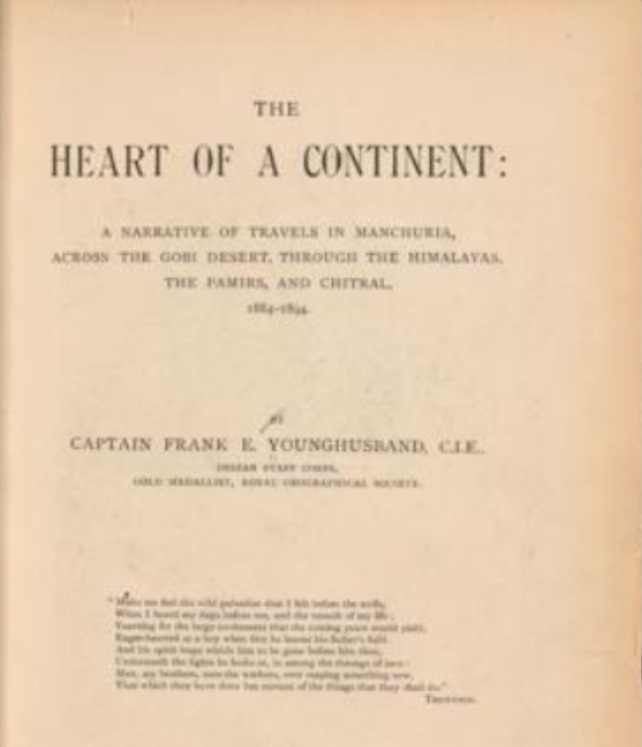 The hearth of a continent
The hearth of a continent

Francis Younghusband was an explorer and soldier best known for leading the controversial British military mission to Lhasa, Tibet in 1903‒4. In 1886 Younghusband was granted leave from his military post in British India to accompany the explorer H.E.M. James on a seven-month journey around Manchuria. After completing this expedition, Younghusband received permission in March 1887 to undertake an overland journey from Peking (Beijing) to India.
Traveling alone with just hired guides, Younghusband crossed the Gobi Desert to reach Hami (China), and proceeded from there over the Himalayan Mountains via Kashgar and the Muztagh Pass to Kashmir.
He reached Srinagar on November 2 and his post at Rawalpindi on November 4, exactly seven months after his departure from Beijing.
Younghusand recorded this journey in the first eight chapters of his The Heart of a Continent.
In 1890‒91 Younghusband undertook further travels to the Pamir Mountains (chiefly in present-day Tajikistan, with parts in Afghanistan, China, and Kyrgyzstan) and the Karakoram Range, the unclaimed corridor between Afghanistan and China. He and his superiors in the Indian government suspected that the Russians might be looking for an invasion route to India through these mountains, and one object of his travels was to search for signs of Russian activity. Younghusband recounted these expeditions in the remaining chapters of the book. The book provides descriptions of spectacular scenery and of the peoples – Chinese, Kalmak (Kalmyk), Kirghiz (Kyrgyz), Tajik, Hunza, and others – that he meets. It also recounts several meetings with Russian reconnoitering parties, including one in the Pamir Mountains in August 1891 with a Russian detachment of more than 30 Cossack soldiers that resulted in a diplomatic clash between Britain and Russia. After an initial friendly meeting, the Russian staff officer in command of the party, Colonel Yonoff, declared that Younghusband was on territory claimed by Russia and that he was under orders to escort the British intruder across the border to China. This encounter led to the lodging of a diplomatic protest by the British embassy in Saint Petersburg and a subsequent apology by the Russian government and an acknowledgement that Yonoff had been operating outside the Russian sphere of influence.
The book contains illustrations and several maps, including a large foldout “Map of the Northern Frontier of India.” Widely praised for his explorations, Younghusband was elected the youngest fellow of the Royal Geographical Society in 1890 and named Companion of the Indian Empire (CIE) in 1891
|